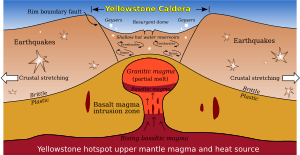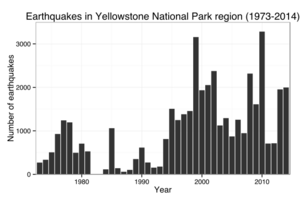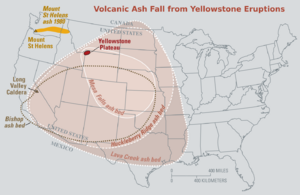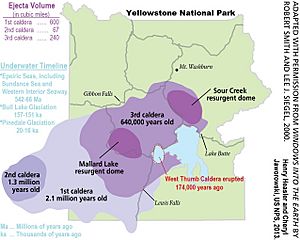Yellowstone hotspot facts for kids

Schematic of the hotspot and the Yellowstone Caldera
|
|

Past locations of the hotspot in millions of years
|
|
| Country | United States |
|---|---|
| State | Idaho/Wyoming |
| Region | Rocky Mountains |
| Coordinates | 44°26′N 110°40′W / 44.43°N 110.67°W |
The Yellowstone hotspot is a special place deep under the United States. It's like a giant, super hot spot of rock that causes volcanic activity. As the North American tectonic plate slowly moves over this hotspot, it creates huge calderas and causes big eruptions.
This hotspot has shaped parts of Idaho, Montana, Nevada, Oregon, and Wyoming. It formed the eastern Snake River Plain with many powerful eruptions. Some of the giant calderas it created include the Island Park Caldera and the Henry's Fork Caldera. Right now, the hotspot is located under the famous Yellowstone Caldera. The last massive eruption from this hotspot happened about 640,000 years ago. It formed the current Yellowstone Caldera. The Yellowstone hotspot is one of several hotspots under North America.
Contents
The Snake River Plain: A Volcanic Trail
The eastern Snake River Plain is a flat, low area that cuts through the Rocky Mountains. It follows the path where the North American tectonic plate moved over the Yellowstone hotspot. Beneath the newer basalt lava flows, you can find older rhyolite lavas and ash from past eruptions.
Later, new volcanoes erupted on the plain after the land moved past the hotspot. These eruptions covered parts of the plain with fresh basalt lava. A great example of this is Craters of the Moon National Monument and Preserve, where you can see many cool lava flows.
Giant Eruptions in Nevada and Oregon
Long ago, between 16.5 and 15.5 million years ago, there were many volcanic eruptions in Nevada and Oregon. Scientists have found several large calderas in northwest Nevada. These include the Virgin Valley Caldera and the McDermitt Caldera. These huge craters formed during a time when a lot of lava was flowing.
The Bruneau-Jarbidge Caldera Eruption
One incredible event happened between 10 and 12 million years ago. The Bruneau-Jarbidge caldera erupted, sending out a thick blanket of ash. This was a massive eruption! Animals within a hundred miles were suffocated and burned by fast-moving pyroclastic flows (hot gas and ash).
Even animals far away suffered. At Ashfall Fossil Beds in northeastern Nebraska, about 1000 miles downwind, a foot of ash fell. This ash preserved over two hundred fossilized rhinoceros and many other animals. Scientists could tell it was from Bruneau-Jarbidge because of its unique chemical makeup. Strong winds carried the ash across a huge part of the Great Plains.
Volcanic Fields: Ancient Eruptions
The Yellowstone hotspot has created many volcanic fields over millions of years. Each field marks a spot where the hotspot was active as the continent moved.
Heise Volcanic Field: A Series of Explosions
The Heise volcanic field in eastern Idaho was very active. It had huge, explosive eruptions that formed calderas. These eruptions started 6.6 million years ago and continued for over 2 million years.
Four very large eruptions happened here. The first three produced a total of at least 2250 cubic kilometers of magma. The last and biggest eruption, called the Kilgore Tuff, happened 4.5 million years ago. It released an incredible 1800 cubic kilometers of ash!
Yellowstone Plateau: Home of the Supervolcano
The Yellowstone Plateau volcanic area has four calderas that are close to each other. West Thumb Lake, a part of Yellowstone Lake, was formed by a smaller caldera that erupted 174,000 years ago.
Henry's Fork Caldera
The Henry's Fork Caldera in Idaho formed from an eruption about 1.3 million years ago. This eruption released over 280 cubic kilometers of ash and rock. The Henry's Fork Caldera is located inside the much larger Island Park Caldera. Even though it's smaller than Island Park, it's still huge at about 18 miles (29 km) long and 23 miles (37 km) wide. You can clearly see its curved rim from many places in the Island Park area.
Of all the calderas made by the Yellowstone Hotspot, the Henry's Fork Caldera is the only one you can clearly see today. The Henry's Fork of the Snake River flows through it, creating beautiful waterfalls like Upper and Lower Mesa Falls.
Island Park Caldera: A Giant of the Past
The Island Park Caldera is older and much bigger than the Henry's Fork Caldera. It measures about 58 miles (93 km) by 40 miles (64 km). This caldera was the source of the Huckleberry Ridge Tuff. This ash layer can be found from southern California all the way to the Mississippi River!
This "supereruption" happened 2.1 million years ago and produced 2500 cubic kilometers of ash. The Island Park Caldera is sometimes called the First Phase Yellowstone Caldera.
Yellowstone Caldera: The Youngest and Most Famous
The youngest of the hotspot calderas is the Yellowstone Caldera. It formed 640,000 years ago and is about 34 miles (55 km) by 45 miles (72 km) wide. Since this last super eruption, there have been smaller eruptions of lava and less violent explosions inside and near the Yellowstone Caldera.
The most recent lava flow happened about 70,000 years ago. The biggest violent eruption since the supereruption created the West Thumb of Yellowstone Lake around 150,000 years ago. Smaller steam explosions also happen. One explosion 13,800 years ago left a 5-kilometer wide crater at Mary Bay on the edge of Yellowstone Lake.
Scientists study the chemistry of the rocks from these volcanoes. They look at things like oxygen isotopes to understand how the magma forms. This helps them guess what might happen in the future. Some signs suggest that the Yellowstone Caldera might be in its final stages. But it could still have another big eruption, similar to what happened at the Heise volcanic field. It might be another 1 to 2 million years before a new supervolcano forms to the northeast, as the North American tectonic plate continues to move over the hotspot.
Eruptive History: A Timeline of Power


The Yellowstone hotspot has caused many eruptions over millions of years. Here are some of the most important ones:
- Recent Lava Flows:
- Craters of the Moon National Monument and Preserve (Great Rift of Idaho): Many lava flows formed between 15,000 and 2,000 years ago.
- Wapi Lava field and King's Bowl blowout: About 2,270 years ago.
- Hell's Half Acre lava field: About 3,250 years ago.
- Shoshone lava field: About 8,400 years ago.
- Yellowstone Caldera:
- Between 70,000 and 150,000 years ago: Many lava flows inside the caldera.
- 640,000 years ago: A massive eruption (VEI 8) created the current Yellowstone Caldera. It produced over 1000 cubic kilometers of Lava Creek Tuff.
- Henry's Fork Caldera:
- 1.3 million years ago: An eruption (VEI 7) formed the Henry's Fork Caldera. It produced 280 cubic kilometers of Mesa Falls Tuff.
- Island Park Caldera:
- 2.1 million years ago: A huge eruption (VEI 8) formed the Island Park Caldera. It produced 2450 cubic kilometers of Huckleberry Ridge Tuff.
- Heise Volcanic Field:
- 4.45 million years ago: The Kilgore Caldera eruption (VEI 8) produced 1800 cubic kilometers of Kilgore Tuff.
- 6.62 million years ago: The Blacktail Caldera eruption produced 1500 cubic kilometers of Blacktail Tuff.
- Bruneau-Jarbidge Volcanic Field:
- 10 to 12.5 million years ago: The Bruneau-Jarbidge caldera eruption caused the famous Ashfall Fossil Beds event.
- McDermitt Volcanic Field:
- Around 15 to 16.5 million years ago: Several large calderas formed here, like the Longridge Caldera.
- Columbia River Basalt Province:
- 14 to 17 million years ago: The Yellowstone hotspot helped trigger huge lava flows in Washington, Oregon, and Idaho. These included the Columbia River Basalt Group (175,000 cubic kilometers of lava) and Steens flood basalts (65,000 cubic kilometers of lava).


